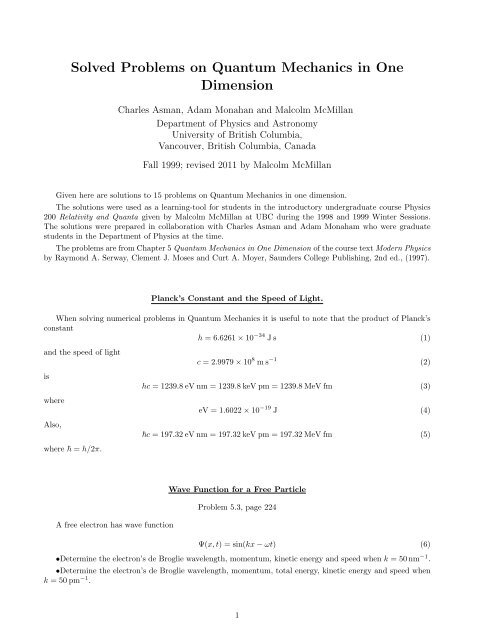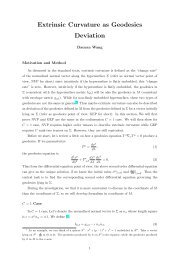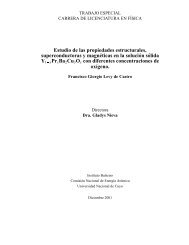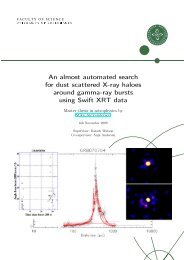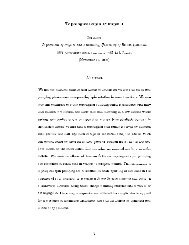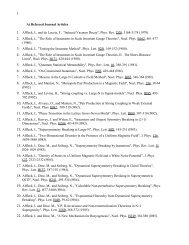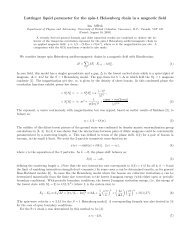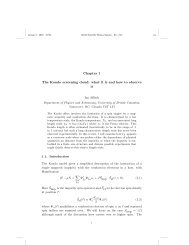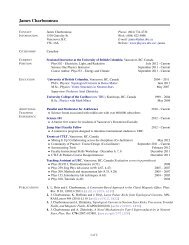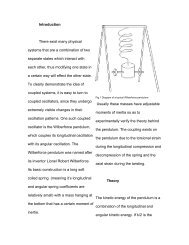Solved Problems on Quantum Mechanics in One Dimension
Solved Problems on Quantum Mechanics in One Dimension
Solved Problems on Quantum Mechanics in One Dimension
Create successful ePaper yourself
Turn your PDF publications into a flip-book with our unique Google optimized e-Paper software.
<str<strong>on</strong>g>Solved</str<strong>on</strong>g> <str<strong>on</strong>g>Problems</str<strong>on</strong>g> <strong>on</strong> <strong>Quantum</strong> <strong>Mechanics</strong> <strong>in</strong> <strong>One</strong><br />
Dimensi<strong>on</strong><br />
Charles Asman, Adam M<strong>on</strong>ahan and Malcolm McMillan<br />
Department of Physics and Astr<strong>on</strong>omy<br />
University of British Columbia,<br />
Vancouver, British Columbia, Canada<br />
Fall 1999; revised 2011 by Malcolm McMillan<br />
Given here are soluti<strong>on</strong>s to 15 problems <strong>on</strong> <strong>Quantum</strong> <strong>Mechanics</strong> <strong>in</strong> <strong>on</strong>e dimensi<strong>on</strong>.<br />
The soluti<strong>on</strong>s were used as a learn<strong>in</strong>g-tool for students <strong>in</strong> the <strong>in</strong>troductory undergraduate course Physics<br />
200 Relativity and Quanta given by Malcolm McMillan at UBC dur<strong>in</strong>g the 1998 and 1999 W<strong>in</strong>ter Sessi<strong>on</strong>s.<br />
The soluti<strong>on</strong>s were prepared <strong>in</strong> collaborati<strong>on</strong> with Charles Asman and Adam M<strong>on</strong>aham who were graduate<br />
students <strong>in</strong> the Department of Physics at the time.<br />
The problems are from Chapter 5 <strong>Quantum</strong> <strong>Mechanics</strong> <strong>in</strong> <strong>One</strong> Dimensi<strong>on</strong> of the course text Modern Physics<br />
by Raym<strong>on</strong>d A. Serway, Clement J. Moses and Curt A. Moyer, Saunders College Publish<strong>in</strong>g, 2nd ed., (1997).<br />
Planck’s C<strong>on</strong>stant and the Speed of Light.<br />
When solv<strong>in</strong>g numerical problems <strong>in</strong> <strong>Quantum</strong> <strong>Mechanics</strong> it is useful to note that the product of Planck’s<br />
c<strong>on</strong>stant<br />
h = 6.6261 × 10 −34 J s (1)<br />
and the speed of light<br />
is<br />
where<br />
Also,<br />
c = 2.9979 × 10 8 m s −1 (2)<br />
hc = 1239.8 eV nm = 1239.8 keV pm = 1239.8 MeV fm (3)<br />
eV = 1.6022 × 10 −19 J (4)<br />
c = 197.32 eV nm = 197.32 keV pm = 197.32 MeV fm (5)<br />
where = h/2π.<br />
A free electr<strong>on</strong> has wave functi<strong>on</strong><br />
Wave Functi<strong>on</strong> for a Free Particle<br />
Problem 5.3, page 224<br />
Ψ(x, t) = s<strong>in</strong>(kx − ωt) (6)<br />
•Determ<strong>in</strong>e the electr<strong>on</strong>’s de Broglie wavelength, momentum, k<strong>in</strong>etic energy and speed when k = 50 nm −1 .<br />
•Determ<strong>in</strong>e the electr<strong>on</strong>’s de Broglie wavelength, momentum, total energy, k<strong>in</strong>etic energy and speed when<br />
k = 50 pm −1 .<br />
1
Soluti<strong>on</strong><br />
The equati<strong>on</strong>s relat<strong>in</strong>g the speed v, momentum p, de Broglie wavelength λ, wave number k, k<strong>in</strong>etic energy<br />
E, angular frequency ω and group velocity v g for a n<strong>on</strong>relativistic particle of mass m are:<br />
When k = 50 nm −1 ,<br />
and, for an electr<strong>on</strong> (m = 511 keV/c 2 ),<br />
p = mv = h = k (7)<br />
λ<br />
E = 1 2 mv2 = p2<br />
2m = 2 k 2<br />
= ω (8)<br />
2m<br />
v g = dω<br />
dk = v (9)<br />
λ = 126 pm p = 9.87 keV/c (10)<br />
E = 95.2 eV v = 1.93 × 10 −2 c (11)<br />
The equati<strong>on</strong>s relat<strong>in</strong>g the speed v, momentum p, de Broglie wavelength λ, wave number k, total energy<br />
E, k<strong>in</strong>etic energy K, angular frequency ω and group velocity v g for a relativistic particle of mass m are:<br />
When k = 50 pm −1 ,<br />
and, for an electr<strong>on</strong> (m = 511 keV/c 2 ),<br />
p = γmv = h = k (12)<br />
λ<br />
E = γmc 2 = mc 2 + K = √ p 2 c 2 + m 2 c 4 = ω (13)<br />
v g = dω<br />
dk = v = pc2<br />
E<br />
1<br />
γ = √<br />
1 − β<br />
2<br />
(14)<br />
(15)<br />
β = v/c (16)<br />
λ = 126 fm p = 9.87 MeV/c (17)<br />
E = 9.88 MeV K = 9.37 MeV v = 0.9987c (18)<br />
Potential Energy of a Particle<br />
Problem 5.5, page 224<br />
In a regi<strong>on</strong> of space, a particle with mass m and with zero energy has a time-<strong>in</strong>dependent wave functi<strong>on</strong><br />
ψ(x) = Axe −x2 /L 2 (19)<br />
where A and L are c<strong>on</strong>stants.<br />
•Determ<strong>in</strong>e the potential energy U(x) of the particle.<br />
Soluti<strong>on</strong><br />
2
Text Eq. (5.13) is the time-<strong>in</strong>dependent Schröd<strong>in</strong>ger equati<strong>on</strong> for the wavefuncti<strong>on</strong> ψ(x) of a particle of<br />
mass m <strong>in</strong> a potential U(x):<br />
− 2 d 2 ψ(x)<br />
2m dx 2 + U(x)ψ(x) = Eψ(x) (20)<br />
When a particle with zero energy has wavefuncti<strong>on</strong> ψ(x) given by Eq. (19), it follows <strong>on</strong> substituti<strong>on</strong> <strong>in</strong>to<br />
Eq. (20) that<br />
( )<br />
U(x) = 22<br />
mL 4 x 2 − 3L2 . (21)<br />
2<br />
U(x) is a parabola centred at x = 0 with U(0) = −3 2 /mL 2 .<br />
Phot<strong>on</strong> Energy From a Transiti<strong>on</strong> <strong>in</strong> an Inf<strong>in</strong>ite Square Well Potential<br />
Problem 5.9, page 224<br />
A prot<strong>on</strong> is c<strong>on</strong>f<strong>in</strong>ed <strong>in</strong> an <strong>in</strong>f<strong>in</strong>ite square well of width 10 fm. (The nuclear potential that b<strong>in</strong>ds prot<strong>on</strong>s<br />
and neutr<strong>on</strong>s <strong>in</strong> the nucleus of an atom is often approximated by an <strong>in</strong>f<strong>in</strong>ite square well potential.)<br />
•Calculate the energy and wavelength of the phot<strong>on</strong> emitted when the prot<strong>on</strong> undergoes a transiti<strong>on</strong> from<br />
the first excited state (n = 2) to the ground state (n = 1).<br />
•In what regi<strong>on</strong> of the electromagnetic spectrum does this wavelength bel<strong>on</strong>g?<br />
Soluti<strong>on</strong><br />
Text Eq. (5.17) gives the energy E n of a particle of mass m <strong>in</strong> the nth energy state of an <strong>in</strong>f<strong>in</strong>ite square<br />
well potential with width L:<br />
E n = n2 h 2<br />
8mL 2 (22)<br />
The energy E and wavelength λ of a phot<strong>on</strong> emitted as the particle makes a transiti<strong>on</strong> from the n = 2 state<br />
to the n = 1 state are<br />
E = E 2 − E 1 =<br />
3h2<br />
8mL 2 (23)<br />
λ = hc<br />
E . (24)<br />
For a prot<strong>on</strong> (m=938 MeV/c 2 ), E = 6.15 MeV and λ = 202 fm. The wavelength is <strong>in</strong> the gamma ray regi<strong>on</strong><br />
of the spectrum.<br />
Wave Functi<strong>on</strong>s for a Particle <strong>in</strong> an Inf<strong>in</strong>ite Square Well Potential<br />
Problem 5.11, page 225<br />
A particle with mass m is <strong>in</strong> an <strong>in</strong>f<strong>in</strong>ite square well potential with walls at x = −L/2 and x = L/2.<br />
•Write the wave functi<strong>on</strong>s for the states n = 1, n = 2 and n = 3.<br />
Soluti<strong>on</strong><br />
Text Eqs. (5.18) and (5.19) give the normalized wave functi<strong>on</strong>s for a particle <strong>in</strong> an <strong>in</strong>f<strong>in</strong>ite square well<br />
potentai with walls at x = 0 and x = L. To obta<strong>in</strong> the wavefuncti<strong>on</strong>s ψ n (x) for a particle <strong>in</strong> an <strong>in</strong>f<strong>in</strong>ite square<br />
potential with walls at x = −L/2 and x = L/2 we replace x <strong>in</strong> text Eq. (5.18) by x + L/2:<br />
√ ( )<br />
2 nπ(x + L/2)<br />
ψ n (x) =<br />
L s<strong>in</strong> (25)<br />
L<br />
3
which satisfies ψ n (−L/2) = ψ n (L/2) = 0 as required. Thus,<br />
√<br />
2<br />
( πx<br />
)<br />
ψ 1 (x) =<br />
L cos L<br />
√ ( )<br />
2 2πx<br />
ψ 2 (x) = −<br />
L s<strong>in</strong> L<br />
√ ( )<br />
2 3πx<br />
ψ 3 (x) = −<br />
L cos L<br />
(26)<br />
(27)<br />
(28)<br />
Positi<strong>on</strong> Probability for a Particle <strong>in</strong> an Inf<strong>in</strong>ite Square Well Potential<br />
Problem 5.16, page 225<br />
A particle is <strong>in</strong> the nth energy state ψ n (x) of an <strong>in</strong>f<strong>in</strong>ite square well potential with width L.<br />
•Determ<strong>in</strong>e the probability P n (1/a) that the particle is c<strong>on</strong>f<strong>in</strong>ed to the first 1/a of the width of the well.<br />
•Comment <strong>on</strong> the n-dependence of P n (1/a).<br />
Soluti<strong>on</strong><br />
The wave functi<strong>on</strong> ψ n (x) for a particle <strong>in</strong> the nth energy state <strong>in</strong> an <strong>in</strong>f<strong>in</strong>ite square box with walls at x = 0<br />
and x = L is<br />
√<br />
2<br />
( nπx<br />
)<br />
ψ n (x) =<br />
L s<strong>in</strong> . (29)<br />
L<br />
The probability P n (1/a) that the electr<strong>on</strong> is between x = 0 and x = L/a <strong>in</strong> the state ψ n (x) is<br />
( ) 1<br />
P n =<br />
a<br />
∫ L/a<br />
0<br />
|ψ n (x)| 2 dx = 2 L<br />
∫ L/a<br />
0<br />
( s<strong>in</strong> 2 nπx<br />
)<br />
dx = 1 s<strong>in</strong> (2nπ/a)<br />
−<br />
L a 2nπ<br />
P n (1/a) is the probability that the particle <strong>in</strong> the state ψ n (x) is c<strong>on</strong>f<strong>in</strong>ed to the first 1/a of the width of<br />
the well. The s<strong>in</strong>usoidal n-dependent term decreases as n <strong>in</strong>creases and vanishes <strong>in</strong> the limit of large n:<br />
( ) 1<br />
P n → 1 as n → ∞ (31)<br />
a a<br />
(30)<br />
P n (1/a) = 1/a is the classical result. The above analysis is c<strong>on</strong>sistent with the corresp<strong>on</strong>dence pr<strong>in</strong>ciple,<br />
which may be stated symbolically as<br />
where n is a typical quantum number of the system.<br />
quantum physics → classical physics as n → ∞ (32)<br />
Applicati<strong>on</strong> of <strong>Quantum</strong> <strong>Mechanics</strong> to a Macroscopic Object<br />
Problem 5.19, page 225<br />
A 1.00 g marble is c<strong>on</strong>stra<strong>in</strong>ed to roll <strong>in</strong>side a tube of length L = 1.00 cm. The tube is capped at both ends.<br />
•Modell<strong>in</strong>g this as a <strong>on</strong>e-dimensi<strong>on</strong>al <strong>in</strong>f<strong>in</strong>ite square well, determ<strong>in</strong>e the value of the quantum number n if<br />
the marble is <strong>in</strong>itially given an energy of 1.00 mJ.<br />
•Calculate the exitati<strong>on</strong> energy required to promote the marble to the next available energy state.<br />
Soluti<strong>on</strong><br />
4
The allowed energy values E n for a particle of mass m <strong>in</strong> a <strong>on</strong>e-dimensi<strong>on</strong>al <strong>in</strong>f<strong>in</strong>ite square well potential<br />
of width L are given by Eq. (22) from which<br />
when E n = 1.00 mJ.<br />
n = 4.27 × 10 28 (33)<br />
The excitati<strong>on</strong> energy E required to promote the marble to the next available energy state is<br />
E = E n+1 − E n =<br />
(2n + 1)h2<br />
8mL 2 = 4.69 × 10 −32 J. (34)<br />
This example illustrates the large quantum numbers and small energy differences associated with the behavior<br />
of macroscopic objects.<br />
Energy Levels for a Particle <strong>in</strong> a F<strong>in</strong>ite Square Well Potential<br />
Problem 5.20, page 225<br />
A particle with energy E is bound <strong>in</strong> a f<strong>in</strong>ite square well potential with height U and width 2L situated at<br />
−L ≤ x ≤ +L.<br />
The potential is symmetric about the midpo<strong>in</strong>t of the well. The stati<strong>on</strong>ary state wave functi<strong>on</strong>s are either<br />
symmetric or antisymmetric about this po<strong>in</strong>t.<br />
•Show that for E < U, the c<strong>on</strong>diti<strong>on</strong>s for smooth jo<strong>in</strong><strong>in</strong>g of the <strong>in</strong>terior and exterior wave functi<strong>on</strong>s leads<br />
to the follow<strong>in</strong>g equati<strong>on</strong> for the allowed energies of the symmetric wave functi<strong>on</strong>s:<br />
where<br />
and<br />
α =<br />
k tan kL = α (35)<br />
√<br />
2m(U − E)<br />
2 . (36)<br />
k =<br />
k is the wave number of oscillati<strong>on</strong> <strong>in</strong> the <strong>in</strong>terior of the well.<br />
•Show that Eq. (35) can be rewritten as<br />
√<br />
2mE<br />
2 (37)<br />
k sec kL =<br />
√<br />
2mU<br />
<br />
(38)<br />
•Apply this result to an electr<strong>on</strong> trapped at a defect site <strong>in</strong> a crystal, model<strong>in</strong>g the defect as a f<strong>in</strong>ite square<br />
well potential with height 5 eV and width 200 pm.<br />
Soluti<strong>on</strong><br />
The wavefuncti<strong>on</strong> ψ(x) for a particle with energy E <strong>in</strong> a potential U(x) satisfies the time-<strong>in</strong>dependent<br />
Schröd<strong>in</strong>ger equati<strong>on</strong> Eq. (20).<br />
Inside the well (−L ≤ x ≤ L), the particle is free. The wavefuncti<strong>on</strong> symmetric about x = 0 is<br />
√<br />
2mE<br />
ψ(x) = A cos kx where k =<br />
2 . (39)<br />
Outside the well (−∞ < x < −L and L < x < ∞), the potential has c<strong>on</strong>stant value U > E. The<br />
wavefuncti<strong>on</strong> symmetric about x = 0 is<br />
ψ(x) = Be −α|x| √<br />
2m(U − E)<br />
where α =<br />
2 . (40)<br />
5
ψ(x) and its derivative are c<strong>on</strong>t<strong>in</strong>uous at x = L:<br />
from which<br />
or, alternatively,<br />
where<br />
and<br />
A cos kL = Be −αL (41)<br />
Ak s<strong>in</strong> kL = Bαe −αL (42)<br />
k tan kL = α (43)<br />
θ sec θ = ±a (44)<br />
a =<br />
θ = kL (45)<br />
√<br />
2mUL<br />
2<br />
2 (46)<br />
Eq. (44) are equati<strong>on</strong>s for the allowed values of k. The equati<strong>on</strong> with the positive sign yields values of θ <strong>in</strong><br />
the first quadrant. The equati<strong>on</strong> with the negative sign yields values of θ <strong>in</strong> the third quadrant.<br />
Solv<strong>in</strong>g Eq. (44) numerically for an electr<strong>on</strong> <strong>in</strong> a well with U = 5 eV and L = 100 pm yields the ground<br />
state energy E = 2.43 eV.<br />
Energy Levels for a Particle <strong>in</strong> a Semi-Inf<strong>in</strong>ite Square Well Potential<br />
Problem 5.23, page 226<br />
C<strong>on</strong>sider a square well hav<strong>in</strong>g an <strong>in</strong>f<strong>in</strong>ite wall at x = 0 and a wall of height U at x = L.<br />
•For the case E < U, obta<strong>in</strong> soluti<strong>on</strong>s to the Schröd<strong>in</strong>ger equati<strong>on</strong> Eq. (20) <strong>in</strong>side the well (0 ≤ x ≤ L) and<br />
<strong>in</strong> the regi<strong>on</strong> bey<strong>on</strong>d (x > L) that satisfy the appropriate boundary c<strong>on</strong>dit<strong>on</strong>s at x = 0 and at x = ∞.<br />
•Enforce the proper match<strong>in</strong>g c<strong>on</strong>diti<strong>on</strong>s at x = L to f<strong>in</strong>d an equati<strong>on</strong> for the allowed energies of the system.<br />
•Are there c<strong>on</strong>diti<strong>on</strong>s for which no soluti<strong>on</strong> is possible? Expla<strong>in</strong>.<br />
Soluti<strong>on</strong><br />
The wavefuncti<strong>on</strong> ψ(x) for a particle with energy E <strong>in</strong> a potential U(x) satisfies the Schröd<strong>in</strong>ger Eq. (20).<br />
Inside the well (0 ≤ x ≤ L), the particle is free. The wavefuncti<strong>on</strong> is<br />
√<br />
2mE<br />
ψ(x) = A s<strong>in</strong> kx where k =<br />
2 . (47)<br />
Outside the well (L < x < ∞), the potential has c<strong>on</strong>stant value U > E. The wavefuncti<strong>on</strong> is<br />
√<br />
2m(U − E)<br />
ψ(x) = Be −αx where α =<br />
2 . (48)<br />
ψ(x) and its derivative are c<strong>on</strong>t<strong>in</strong>uous at x = L:<br />
from which<br />
or, alternatively,<br />
where θ and a are given by Eqs. (45) and (46).<br />
A s<strong>in</strong> kL = Be −αL (49)<br />
Ak cos kL = −Bαe −αL (50)<br />
k cot kL = −α (51)<br />
θ csc θ = ±a (52)<br />
6
Eq. (52) are equati<strong>on</strong>s for the allowed values of k. The equati<strong>on</strong> with the positive sign yields values of θ <strong>in</strong><br />
the sec<strong>on</strong>d quadrant. The equati<strong>on</strong> with the negative sign yields values of θ <strong>in</strong> the fourth quadrant.<br />
S<strong>in</strong>ce s<strong>in</strong> θ ≤ θ ∀θ, it follows from Eq. (52) that there are no bound states if UL 2 ≤ 2 /2m.<br />
The wave functi<strong>on</strong><br />
Wave Functi<strong>on</strong> for the First Excited State of a Harm<strong>on</strong>ic Oscillator<br />
Problem 5.25, page 226<br />
ψ(x) = Axe −αx2 (53)<br />
describes a state of a harm<strong>on</strong>ic oscillator provided the c<strong>on</strong>stant α is chosen appropriately.<br />
• Us<strong>in</strong>g the Schröd<strong>in</strong>ger Eq. (20), determ<strong>in</strong>e an expressi<strong>on</strong> for α <strong>in</strong> terms of the oscillator mass m and the<br />
classical frequency of vibrati<strong>on</strong> ω.<br />
•Determ<strong>in</strong>e the energy of this state and normalize the wave functi<strong>on</strong>.<br />
Soluti<strong>on</strong><br />
Eq. (20) is the Schröd<strong>in</strong>ger equati<strong>on</strong> for a harm<strong>on</strong>ic oscillator when<br />
U(x) = 1 2 Kx2 = 1 2 mω2 x 2 where ω = ω classical =<br />
√<br />
K<br />
m<br />
(54)<br />
ψ(x) given by Eq. (53) satisfies Eq. (20) when<br />
α = mω<br />
2<br />
and E = 3 ω (55)<br />
2<br />
Eq. (53) gives the wave functi<strong>on</strong> of the first excited state of the harm<strong>on</strong>ic oscillator. Requir<strong>in</strong>g that<br />
yields<br />
∫ +∞<br />
−∞<br />
∣ ∣ ψ(x)<br />
2 dx = 1 (56)<br />
( ) 32α<br />
3 1/4<br />
|A| =<br />
. (57)<br />
π<br />
Average Positi<strong>on</strong> of a Particle<br />
Problem 5.30, page 226<br />
An electr<strong>on</strong> is described by the wave functi<strong>on</strong><br />
{<br />
0 for x < 0<br />
ψ(x) =<br />
Ce −x (1 − e −x ) for x > 0,<br />
(58)<br />
where x is <strong>in</strong> nm and C is a c<strong>on</strong>stant.<br />
•Determ<strong>in</strong>e the value of C that normalizes ψ(x).<br />
•Where is the electr<strong>on</strong> most likely to be found? That is, for what value of x is the probability of f<strong>in</strong>d<strong>in</strong>g<br />
the electr<strong>on</strong> the largest?<br />
•Calculate the average positi<strong>on</strong> 〈x〉 for the electr<strong>on</strong>. Compare this result with the most likely positi<strong>on</strong>, and<br />
comment <strong>on</strong> the difference.<br />
Soluti<strong>on</strong><br />
7
An electr<strong>on</strong> is described by the wave functi<strong>on</strong> ψ(x) given by Eq. (58). Requir<strong>in</strong>g that Eq. (56) holds yields<br />
|C| = 2 √ 3 nm −1/2 . (59)<br />
The most likely place x m for the electr<strong>on</strong> to be is where |ψ(x)| 2 is maximum or, <strong>in</strong> this case, where ψ(x) is<br />
maximum. It follows from Eq. (58) that<br />
x m = ln 2 nm = 0.693 nm (60)<br />
It follows from text Eqs. (5.11) and (5.31) that the average positi<strong>on</strong> 〈x〉 of a particle <strong>in</strong> a stati<strong>on</strong>ary state<br />
ψ(x) is<br />
It follows from Eqs. (58) and (61) that<br />
〈x〉 =<br />
∫ +∞<br />
−∞<br />
x |ψ(x)| 2 dx (61)<br />
〈x〉 = 13 nm ≃ 1.083 nm. (62)<br />
12<br />
〈x〉 > x m because, accord<strong>in</strong>g to Eq. (58), values of x > x m are weighted more heavily <strong>in</strong> determ<strong>in</strong><strong>in</strong>g 〈x〉.<br />
Positi<strong>on</strong> Properties of a <strong>Quantum</strong> Oscillator <strong>in</strong> its Ground State<br />
Problem 5.33, page 227<br />
•Calculate 〈x〉, 〈x 2 〉 and ∆x for a quantum oscillator <strong>in</strong> its ground state.<br />
where<br />
Soluti<strong>on</strong><br />
The normalized wave functi<strong>on</strong> ψ 0 (x) for the ground state of the quantum oscillator is<br />
C 0 =<br />
( mω<br />
) 1<br />
4<br />
π<br />
ψ 0 (x) = C 0 e −αx2 (63)<br />
α = mω<br />
2<br />
E = 1 ω (64)<br />
2<br />
ψ 0 (x) is the soluti<strong>on</strong> of the Schröd<strong>in</strong>ger Eq. (20) when U(x) is the harm<strong>on</strong>ic oscillator potential given by<br />
Eq. (54).<br />
where<br />
It follows from Eq. (61) that<br />
〈x〉 = 0. (65)<br />
The uncerta<strong>in</strong>ty ∆x <strong>in</strong> the positi<strong>on</strong> of a particle <strong>in</strong> a stati<strong>on</strong>ary state ψ(x) as<br />
〈x 2 〉 =<br />
∆x = √ 〈x 2 〉 − 〈x〉 2 (66)<br />
∫ +∞<br />
−∞<br />
x 2 |ψ(x)| 2 dx. (67)<br />
For the ground state of the quantum oscillator,<br />
√<br />
<br />
∆x =<br />
2mω . (68)<br />
Momentum Properties of a <strong>Quantum</strong> Oscillator <strong>in</strong> its Ground State<br />
8
Problem 5.34, page 227<br />
•Calculate 〈p〉, 〈p 2 〉 and ∆p for a quantum oscillator <strong>in</strong> its ground state.<br />
where<br />
Soluti<strong>on</strong><br />
The average momentum 〈p〉 of a particle <strong>in</strong> a stati<strong>on</strong>ary state ψ(x) is<br />
〈p〉 = −i<br />
∫ +∞<br />
−∞<br />
ψ ∗ (x) dψ(x) dx (69)<br />
dx<br />
The uncerta<strong>in</strong>ty ∆p <strong>in</strong> the momentum of a particle <strong>in</strong> a stati<strong>on</strong>ary state ψ(x) is<br />
∆p = √ 〈p 2 〉 − 〈p〉 2 (70)<br />
〈p 2 〉 = − 2 ∫ +∞<br />
−∞<br />
ψ ∗ (x) d2 ψ(x)<br />
dx 2 dx (71)<br />
Eq. (63) gives the wave functi<strong>on</strong> of the ground state of the quantum oscillator. For this state,<br />
〈p〉 = 0 (72)<br />
√<br />
mω<br />
∆p =<br />
2 . (73)<br />
The Ground State of a <strong>Quantum</strong> Oscillator is an Optimum State of Positi<strong>on</strong> and Momentum<br />
Problem 5.35, page 227<br />
ψ(x) is said to be an optimum state of positi<strong>on</strong> and momentum if for this state<br />
∆x∆p = /2 (74)<br />
That is, for an optimum state, the product of the uncerta<strong>in</strong>ties of positi<strong>on</strong> and momentum is the smallest value<br />
allowed by Heisenberg’s Uncerta<strong>in</strong>ty Relati<strong>on</strong>:<br />
∆x∆p ≥ /2 (75)<br />
•Show that the ground state of the harm<strong>on</strong>ic oscillator is an optimum state.<br />
Soluti<strong>on</strong><br />
It follows from Eqs. (68) and (73) that Eq. (74) holds for ψ(x) given by Eq. (63). That is, the ground state<br />
of the quantum oscillator is an optimum state of positi<strong>on</strong> and momentum.<br />
Average Energy and Uncerta<strong>in</strong>ty of Energy of a Particle <strong>in</strong> a N<strong>on</strong>stati<strong>on</strong>ary State<br />
Problem 5.39, page 227<br />
A particle <strong>in</strong> a potential well U(x) is <strong>in</strong>itially <strong>in</strong> a state whose wavefuncti<strong>on</strong> Ψ(x, 0) is an equal-weight<br />
superpositi<strong>on</strong> of the ground state and first excited state wavefuncti<strong>on</strong>s:<br />
Ψ(x, 0) = C[ψ 1 (x) + ψ 2 (x)] (76)<br />
•Show that the value C = 1/ √ 2 normalizes Ψ(x, 0), assum<strong>in</strong>g that ψ 1 and ψ 2 are themselves normalized.<br />
•Determ<strong>in</strong>e Ψ(x, t) at any later time t.<br />
•Show that the average energy 〈E〉 for Ψ(x, t) is the arithmetic mean of the ground and first excited state<br />
energies E 1 and E 2 , that is 〈E〉 = (E 1 + E 2 )/2.<br />
•Determ<strong>in</strong>e the uncerta<strong>in</strong>ty ∆E of energy for Ψ(x, t).<br />
9
Soluti<strong>on</strong><br />
The stati<strong>on</strong>ary state wavefuncti<strong>on</strong>s ψ n (x) are soluti<strong>on</strong>s of Eq. (20) and are orth<strong>on</strong>ormal:<br />
∫ +∞<br />
−∞<br />
ψ ∗ m(x)ψ n (x)dx = δ mn (77)<br />
where δ mn is the Kr<strong>on</strong>ecker δ-functi<strong>on</strong> (δ mm = 1; δ mn = 0 when m ≠ n) and ψ n (x) corresp<strong>on</strong>ds to energy E n .<br />
The wavefuncti<strong>on</strong> Ψ(x, t) is normalized:<br />
so<br />
∫ +∞<br />
−∞<br />
∣ ∣ Ψ(x, t)<br />
2 dx = 1 (78)<br />
C = 1 √<br />
2<br />
. (79)<br />
At time t,<br />
Ψ(x, t) = 1 √<br />
2<br />
[ψ 1 (x)e −iE1t/ + ψ 2 (x)e −iE2t/] . (80)<br />
It follows from text Eqs. (5.37) and (5.40) that the average energy 〈E〉 of the particle is<br />
〈E〉 = i<br />
∫ +∞<br />
−∞<br />
Ψ ∗ (x, t)<br />
and from text Eq. (5.41) that the uncerta<strong>in</strong>ty ∆E <strong>in</strong> the energy is<br />
∂Ψ(x, t)<br />
dx (81)<br />
∂t<br />
∆E = √ 〈E 2 〉 − 〈E〉 2 (82)<br />
where<br />
It follows from Eq. (80) that<br />
〈E 2 〉 = − 2 ∫ +∞<br />
−∞<br />
Ψ ∗ (x, t) ∂2 Ψ(x, t)<br />
∂t 2 dx (83)<br />
〈E〉 = 1 2 (E 1 + E 2 ) (84)<br />
∆E = 1 2 (E 2 − E 1 ). (85)<br />
That is, the average energy 〈E〉 for Ψ(x, t) is the arithmetic mean of the ground and first excited state energies<br />
E 1 and E 2 . Now,<br />
∆E = E 2 − 〈E〉 = 〈E〉 − E 1 (86)<br />
so the uncerta<strong>in</strong>ty ∆E <strong>in</strong> the energy is the difference between first excited state energy and the average energy,<br />
or, equivalently, between the average energy and the ground state energy.<br />
Average Positi<strong>on</strong> of a Particle <strong>in</strong> a N<strong>on</strong>stati<strong>on</strong>ary State<br />
Problem 5.40, page 227<br />
•Determ<strong>in</strong>e the average positi<strong>on</strong> 〈x(t)〉 of a particle with n<strong>on</strong>stati<strong>on</strong>ary state wave functi<strong>on</strong> Ψ(x, t) given<br />
by Eq. (80).<br />
Soluti<strong>on</strong><br />
10
where<br />
Text Eq. (5.31) gives the average positi<strong>on</strong> 〈x(t)〉 of a particle <strong>in</strong> a state Ψ(x, t) as<br />
〈x(t)〉 =<br />
∫ +∞<br />
For a particle <strong>in</strong> the state Ψ(x, t) given by Eq. (80) it follows that<br />
x 0 = 1 2<br />
−∞<br />
x |Ψ(x, t)| 2 dx (87)<br />
〈x(t)〉 = x 0 + a cos(t/τ) (88)<br />
a =<br />
∫ +∞<br />
−∞<br />
∫ +∞<br />
−∞<br />
x [ ψ 2 1(x) + ψ 2 2(x) ] dx (89)<br />
xψ 1 (x)ψ 2 (x)dx (90)<br />
τ =<br />
<br />
2∆E<br />
where ∆E is given by Eq. (85) and where we have chosen the stati<strong>on</strong>ary state wave functi<strong>on</strong>s to be real.<br />
The average positi<strong>on</strong> of the particle oscillates about x 0 with amplitude a and period 2πτ.<br />
It follows from the energy-time uncerta<strong>in</strong>ty relati<strong>on</strong> [text Eq. (4.34)]:<br />
(91)<br />
∆E∆t ≥ /2 (92)<br />
that τ is the m<strong>in</strong>imum time required to observe a change <strong>in</strong> the average positi<strong>on</strong> of the particle.<br />
For an electr<strong>on</strong> <strong>in</strong> an <strong>in</strong>f<strong>in</strong>ite square well potential with width L = 100 pm, τ=5.83 as.<br />
For a prot<strong>on</strong> <strong>in</strong> an <strong>in</strong>f<strong>in</strong>ite square well potential with width L=10 fm, τ=107 as.<br />
11


